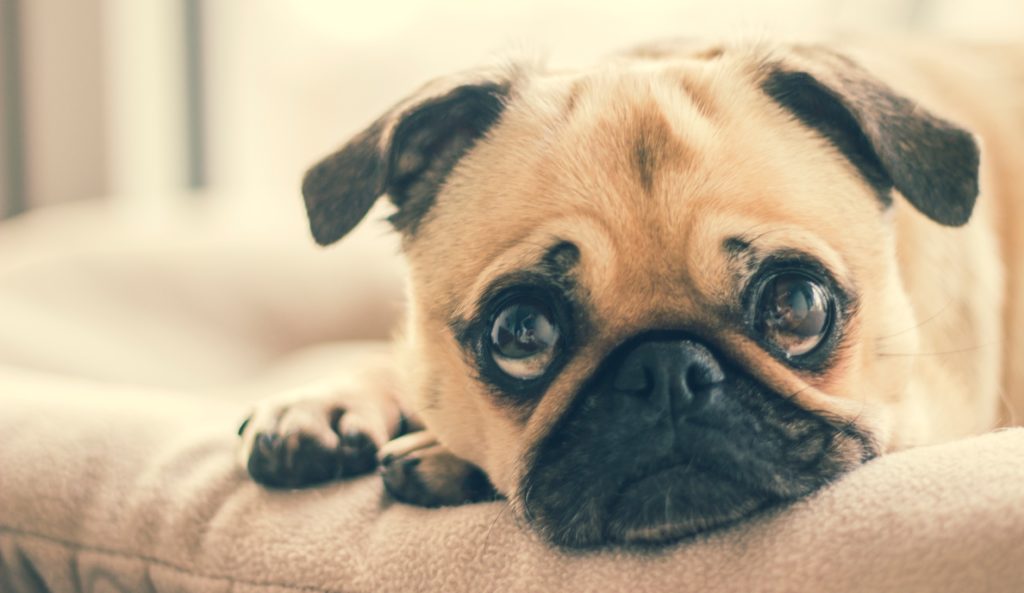
What’s worse than seeing your dog in pain? Not much. And if you have ever experienced a urinary tract infection, also known as bacterial cystitis, you know the disease is quite painful. Unfortunately, dogs can get urinary tract infections (UTIs) just like their humans.
Bacterial UTIs are the most common infectious diseases in dogs, according to the Merck Veterinary Manual. They estimate the disease affects 14% of all dogs during their lifetime. Where does the disease come from and what should you look out for? These are some of the key facts you need to know about urinary tract infections in dogs.

What causes a UTI in a dog?
The main cause of infection is bacteria, fungi, or parasites in the urinary tract (the kidneys, ureters, bladder, and urethra). Bacteria enters your dog’s body via the urethral opening. It can develop when stool or other debris come in contact with the area. Urine in your dog’s bladder should be sterile, but if bacteria moves into your pup’s bladder, it can grow and replicate, causing the UTI. E. coli and Proteus bacteria are most often the cause of the infection.
Some dogs are more at risk for a UTI than others. If your dog has lots of skin folds or is overweight, they are more likely to get the infection. Dogs older than seven-years-old also have an increased chance of getting the disease.
What are the symptoms?
One common signal that your dog is suffering from a UTI is increased need to urinate. Maybe your dog starts asking to be let out more frequently. If your dog is female she might squat several times similar to the way a male dog marks his terrority. Some of the other most obvious signs of the disease are:
- Fever
- Accidents in the house
- Bloody or cloudy urine
- Signs of distress during urination like whining or whimpering
- Increased licking at the urinary opening
- Small amounts of frequent urination
These symptoms indicate something is amiss with your dog. It may be a UTI or it could be something else. Call your vet if you observe changes in your dog’s behavior or distress.
Sometimes dogs will not show any signals of a UTI – that’s why it is important to bring your dog for a regular physical with a veterinarian.


How can you prevent this disease?
These aren’t foolproof suggestions for UTI prevention, but they do promote a healthy lifestyle for your pup.
When possible, eliminate breeding places for bacteria. Clean your dog’s water bowl frequently, especially if you see drool or food floating in the water.
Give your dog plenty of opportunities to relieve their bladder. Don’t make them hold their urine for incredibly long periods of times.
Keep your dog well groomed. If you have a long-haired pooch, make sure the hair around the hindquarters is kept short. When your dog gets super dirty, give her a bath or wipe her down with doggy wipes to get rid of bacteria.
Wag! suggests altering and enhancing your dog’s diet to promote urinary health. There are prescription diets made especially for dogs with bladder problems. Some dogs get supplements like marshmallow root and glucosamine. These dietary additions help to form a protective mucus layer over the bladder wall to keep bacteria out. Remember: don’t make changes to your dog’s diet without talking to your vet first.

What is the treatment?
After your vet does a physical examination, they will conduct a urinalysis, and complete blood count to concretely determine if your dog has the infection. The vet will need a urine sample to conduct the analysis. Your vet will look for bacteria, crystals, and protein in your pup’s urine. If the test is positive, your dog will most likely receive antibiotics to kill the infection.
Are there home remedies?
Yes. However, we strongly urge you to contact your dog’s vet before attempting a home remedy. The last thing you want is to potentially cause more pain or trouble for your dog. The Canine Journal offers these six home treatments:
- Add one teaspoon (for small dogs) or 1-2 tablespoons (for big dogs) of apple cider vinegar to your dog’s water bowl. Repeat up to two times per day for up to seven to ten days, depending on how severe the UTI is. Be sure to have a second bowl of water without apple cider vinegar in case your dog doesn’t like the taste.
- Have your dog soak in a hot bath (make sure it’s not too hot and the level isn’t too deep) for ten minutes to help relieve the muscles. Wash your dog with a mild soap and pay attention to the genital area. Don’t leave soap on the area for too long and be sure to rinse the area with clean, warm water. Do this every few days until the UTI is gone.
- Encourage your dog to drink more water by placing extra water bowls around the house. Change the water once or twice a day to make sure it’s fresh.
- Crush one 500mg Vitamin C tablet and sprinkle it over your dog’s food. Do this once per day for seven days.
- Give your dog one to three teaspoons of citrus juice. The juice should NOT be from concentrate and SHOULD be all natural. Make sure there is no added sugar because it could aggravate your dog’s UTI further.
- Add about two teaspoons of chopped blueberries or cranberries to your dog’s food. Do this twice per day for seven to ten days
You may wonder if cranberry juice is as effective a remedy for dogs as it is humans. This is a potentially helpful treatment for your dog, but again, we recommend running this by your vet before giving the drink to your pooch. Every dog is different and the sugary drink could potentially be harmful.

Keep an eye on your pup
Is your dog acting differently than normal? Are you noticing some troubling signs like blood in his urine? The most important thing you can do is this: know your dog’s behaviors. Be aware of changes in your dog’s regular habits. Those are the signals that it’s time, at a minimum, to call your vet. And now that you know the signs of a UTI, you can give your vet all the information she needs to diagnose your pup.
Do you want a healthier & happier dog? Join our email list & we’ll donate 1 meal to a shelter dog in need!
Be the first to comment